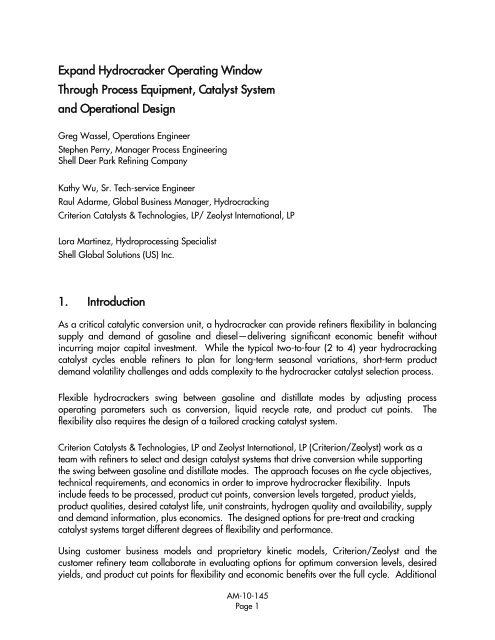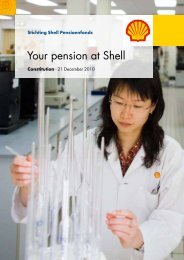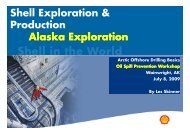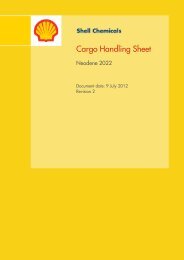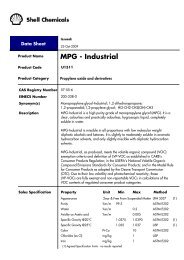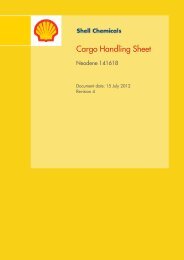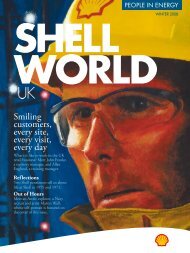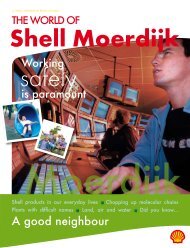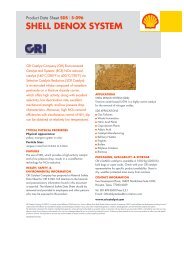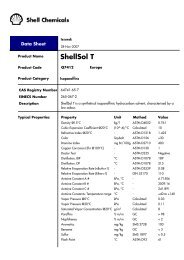Expand Hydrocracker Operating Window Through Process ...
Expand Hydrocracker Operating Window Through Process ...
Expand Hydrocracker Operating Window Through Process ...
- No tags were found...
You also want an ePaper? Increase the reach of your titles
YUMPU automatically turns print PDFs into web optimized ePapers that Google loves.
<strong>Expand</strong> <strong>Hydrocracker</strong> <strong>Operating</strong> <strong>Window</strong><strong>Through</strong> <strong>Process</strong> Equipment, Catalyst Systemand Operational DesignGreg Wassel, Operations EngineerStephen Perry, Manager <strong>Process</strong> EngineeringShell Deer Park Refining CompanyKathy Wu, Sr. Tech-service EngineerRaul Adarme, Global Business Manager, HydrocrackingCriterion Catalysts & Technologies, LP/ Zeolyst International, LPLora Martinez, Hydroprocessing SpecialistShell Global Solutions (US) Inc.1. IntroductionAs a critical catalytic conversion unit, a hydrocracker can provide refiners flexibility in balancingsupply and demand of gasoline and diesel—delivering significant economic benefit withoutincurring major capital investment. While the typical two-to-four (2 to 4) year hydrocrackingcatalyst cycles enable refiners to plan for long-term seasonal variations, short-term productdemand volatility challenges and adds complexity to the hydrocracker catalyst selection process.Flexible hydrocrackers swing between gasoline and distillate modes by adjusting processoperating parameters such as conversion, liquid recycle rate, and product cut points. Theflexibility also requires the design of a tailored cracking catalyst system.Criterion Catalysts & Technologies, LP and Zeolyst International, LP (Criterion/Zeolyst) work as ateam with refiners to select and design catalyst systems that drive conversion while supportingthe swing between gasoline and distillate modes. The approach focuses on the cycle objectives,technical requirements, and economics in order to improve hydrocracker flexibility. Inputsinclude feeds to be processed, product cut points, conversion levels targeted, product yields,product qualities, desired catalyst life, unit constraints, hydrogen quality and availability, supplyand demand information, plus economics. The designed options for pre-treat and crackingcatalyst systems target different degrees of flexibility and performance.Using customer business models and proprietary kinetic models, Criterion/Zeolyst and thecustomer refinery team collaborate in evaluating options for optimum conversion levels, desiredyields, and product cut points for flexibility and economic benefits over the full cycle. AdditionalAM-10-145Page 1
evaluations include consideration of retrofitting existing reactor internals with Shell GlobalSolutions‘ 1 state-of-the-art reactor internals to improve liquid distribution for maximum catalystutilization and to reduce radial delta temperatures throughout the cycle, assuring the catalystsystem reliability and performance. [1, 2, 3]As described in this paper, the collaboration of Deer Park Refining Company (DPRC), ShellGlobal Solutions, and Criterion/Zeolyst (collectively, the team) resulted in improving unitprofitability during the 2007 cycle for the DPRC hydrocracker. The combination of the catalystsystem, the new reactor internals, and operating strategy enabled DPRC to expand operatingwindow and to generate additional operating profit of tens of millions of dollars while flexiblyadjusting to the variable market demand for gasoline and diesel. The results substantiate readysolutions to the dual challenges of more stringent environmental regulations and the changingpattern of market driven product demand.2. Catalyst SelectionThe hydrocracking unit at DPRC has single stage reactors in a series flow configuration. Itconverts heavy straight run gasoil (SRHGO) and light cycle oil (LCO) into more valuableproducts. The 2007 cycle objectives of the DPRC hydrocracker were to increase unit throughputagainst a gas-making constraint and to have a flexible catalyst system enabling maximization ofnaphtha or diesel production based on market demands.To meet the cycle objectives, the team worked together to develop technical solutions for theDPRC hydrocracking unit to improve unit and refinery profitability. Besides the base feed case,the team also investigated different feed cases, such as processing more VGO feed to increasediesel production or shifting more VGO feed from the hydrocracker to the FCC unit to increaserefinery gasoline production and process additional LCO feed generated from the FCC unit inthe hydrocracker, depending on the market demand. Since the unit was mainly constrained bythe gas handling capability and pre-treat catalyst cycle life, the team also evaluated differentoptions to reduce gas-make and improve pre-treat catalyst life to expand the unit operatingwindow. The detailed catalyst system selection process for the pre-treat and cracking catalysts isanalyzed in the following section.a. Pre-Treat Catalyst SystemIn the previous cycle, the catalyst cycle life for the DPRC hydrocracker was limited by thepre-treat catalyst life. Figure 1 shows how the unit had to process less difficult feeds(Feeds containing higher percentage of 650ºF minus material) by the middle of the cycle.The refinery had to reduce throughput in the last part of the cycle in order to meet1 Shell Global Solutions is a network of independent technology companies in the Shell Group. In this publication theexpression 'Shell Global Solutions' is sometimes used for convenience where reference is made to these companies ingeneral, or where no useful purpose is served by identifying a particular company.AM-10-145Page 2
equired nitrogen slip and to reach the targeted catalyst cycle life. The pre-treat catalystcycle life was limited by the bed peak temperature as shown in Figure 2. It can be seenthat bed axial delta temperature decreased as the bed peak temperature increasedtoward end of the run, showing hydrogenation reaction rate was not increased byincreasing bed temperature. This is an indication of the reaction being controlled byequilibrium.Figure 1 – Combined Feed Rate and Percent (%) 650ºF Minus in the Previous CycleFigure 1 shows the percent of 650ºF minus in the combined feed and fresh feed rate in theprevious cycle. Percent of 650ºF minus and fresh feed rate are on the Y axis and days onstream is on the X axis. Toward the middle of the cycle,(point A) the unit had to increase thepercentage of 650ºF minus material and toward the end of the cycle (point B) the unit had toreduce feed rate in order to meet the targeted cycle life.AM-10-145Page 3
Figure 2 – Bed Peak Temperature and Bed dT in One (1) of the Pre-Treat Bed in the Previous CycleFigure 2 shows bed peak temperature and bed dT in one of the pre-treat bed of the Deer Parkhydrocracker in the previous cycle. Bed dT and bed peak temperature are on the Y axis anddays on stream is on the X axis. It is observed that bed dT decreased as the peak temperatureincreased toward end of the run.The peak temperature and denitrification limitations are a result of aromatic saturationequilibrium. This can be explained as follows: Nitrogen is present in hydrocracker feedsas heteroatoms in poly-ring aromatic compounds. Adjacent aromatic rings must besaturated before these nitrogen molecules can be converted into ammonia and removed.Figure 3 shows one example of how aromatic saturation (ASAT) conversion is affected bytemperature and LHSV at constant hydrogen partial pressure [4]. Percent saturation is onthe Y axis and temperature is on the X axis. In the low temperature region, LHSV has abig effect on saturation, showing that the reaction rate is controlled by kinetics. In thisregion, for a given LHSV, an increase in reactor temperature increases aromaticsaturation conversion and denitrification activity. It can also be seen that in the hightemperature region, as temperature increases, the effect o f LHSV is reduced. Eventuallyit has no effect, indicating that the reaction rate is controlled by ASAT equilibrium. Forthe example in Figure 3, aromatic saturation equilibrium becomes the rate-limiting step ata reaction temperature of around 720°F for a LHSV of four (4) or 700°F for a LHSV oftwo (2). These temperatures are much lower than the maximum allowable operatingAM-10-145Page 4
Aromatic Saturation (Wt%)temperature of the reactor. Therefore, breaking this ASAT equilibrium barrier is animportant element of getting the most performance from the hydrocracking unit.1009080706050403020100KineticEquilibriumRegionRegion600 625 650 675 700 725 750WABT ( F)EquilibriumLHSV 0.5LHSV 0.75LHSV 1.0LHSV 2.0LHSV 4.0Figure 3 - Aromatic Saturation Kinetics: LHSV Effect (at Constant H 2 pp)Figure 3 shows how aromatic saturation (ASAT) conversion is affected by temperature andLHSV at constant hydrogen partial pressure. Percent aromatic saturation is on the Y axis, andtemperature is on the X axis. In the low temperature region, LHSV has a big effect onsaturation, showing that the reaction rate is controlled by kinetics (kinetic region). In thisregion, for a given LHSV, an increase in reactor temperature increases aromatic saturationconversion and denitrification activity. It can also be seen that in the high temperature region,as temperature increases, the effect of LHSV is reduced and eventually it has no effect,indicating that the reaction rate is controlled by ASAT equilibrium (equilibrium region).One (1) way to extend the pre-treat catalyst cycle life is to remove the species generatedfrom the aromatic saturation reaction and to shift the reaction toward higher conversion.Criterion/Zeolyst customers have access to special pre-treat catalyst systems to move thepre-treat catalyst operating temperature closer to the metallurgical temperature limit ofthe hydrocracker while maintaining the required HDN activity of the pre-treat catalystsystem. These hydrocracker pre-treat catalyst systems are stacked beds of state-of-the-artalumina hydrotreating catalyst like CENTINEL Gold, ASCENT, or CENTERA ®, combinedwith tailored amorphous silica alumina (ASA) catalysts like Z-503, Z-513, and Z-2513as shown in Figure 4 (pre-treat catalyst portfolio).AM-10-145Page 5
Figure 4 – Criterion <strong>Hydrocracker</strong> Pre-Treat Catalyst PortfolioThe tailored ASA catalysts are nitrogen-tolerant cracking catalysts with enhanced aciditycompared to a conventional hydrotreating catalyst, and they have the power to break opensaturated ring-compounds. Ring opening is irreversible, so it breaks through the aromaticsaturation equilibrium barrier and significantly increases the rate of hydrodenitrification attemperatures above the normal ASAT equilibrium barrier. The DPRC <strong>Hydrocracker</strong> CycleOptimization Team designed a stacked bed system in the 2007 cycle to maximize the pre-treatbed operating temperature window for their hydrocracker. Figure 5 shows examples of differentcustomers that are using this technology successfully at different optimum levels of the ASAcatalysts in the stacked system. Each hydrocracker has its optimum stacked bed system andCriterion/Zeolyst works with each customer to determine it. From the different options designedand evaluated, the team ofDPRC, Criterion/Zeolyst, and Shell Global Solutions selected ahydrocracking pre-treat catalyst stack system of CENTINEL Gold DN-3300 and ASA Z-503.AM-10-145Page 6
Figure 5 – Zeolyst ASA volume in Hydrocracking Pre-Treaters Commercial LoadingFigure 5 shows Zeolyst ASA catalyst in hydrocracking pre-treaters commercial loading. Thevolume percent of Zeolyst ASA is on the Y axis and type of hydrocracker is on the X axis.AM-10-145Page 7
Figure 6 shows the peak temperature and bed dT of one of pre-treat bed in the DPRChydrocracker in the 2007 cycle. With the optimized stacked bed catalyst system, thisbed was operated at 7ºF higher peak temperature at end of run compared to theprevious cycle. The delta temperature in this bed was healthy throughout the full cycle.In the previous cycle, this bed DT went down as the peak temperature reached the ASATequilibrium (Figure 2).Figure 6 – DPRC <strong>Hydrocracker</strong> Pre-treat Bed Peak Temperature and Bed dT(One (1) of the Pre-Treated Beds Loaded with the Stacked Catalyst System in 2007 Cycle)Figure 6 shows the peak temperature and dT of one (1) of the pre-treat beds in the Deer Parkhydrocracker optimized with the stacked hydrotreating/ASA catalyst system. Thehydrocracker was able to operate at 7ºF higher peak temperature in the 2007 cycle comparedto previous cycle while maintaining healthy delta temperatures in the bed.AM-10-145Page 8
Figure 7 shows how the DPRChydrocracker feed rate and feed qualities were wellmaintained throughout the entire 2007 cycle, as opposed to the previous cycleperformance shown in Figure 1. The stacked bed system extended the pre-treat catalystcycle life and allowed the hydrocracker to operate at higher feed rate while processingmore difficult feed. This created significant economic benefit for the refinery.Figure 7 – Combined Feed Rate and Percent (%) 650ºF Minus in the 2007 CycleFigure 7 shows the percent of 650ºF minus material in the combined feed and fresh feed rate inthe 2007 cycle. Percent of 650ºF minus and fresh feed rate are on the Y axis and days on streamare on the X axis. The plot shows that the feed rate and feed quality were well maintainedthroughout the entire 2007 cycle as opposed to the previous cycle shown in Figure 1.AM-10-145Page 9
. Cracking Catalyst SystemCriterion/Zeolyst have been leading innovators in hydrocracking catalyst technology formany years. By having an integrated research and manufacturing capability, thecompanies have been able to create a wide variety of products to meet specific needs ofeach refiner as shown in Figure 8 below.Figure 8 - A Portion of the Criterion Hydrocracking Catalyst PortfolioFigure 8 shows a portion of the Criterion/Zeolyst cracking catalyst portfolio. The middle distillateselectivity is on the Y axis and cracking activity is on the X axis. The cracking catalyst activity isincreased from left to right. The distillate selectivity is increased from bottom to top. Z-803catalyst is a naphtha/distillate flexible cracking catalyst.In the previous cycles, the DPRC hydrocracker was loaded with Criterion/Zeolyst naphthaselective cracking catalysts, Criterion/Zeolyst Z-863 and Z-753, which worked well forthe cycle objectives and refinery economics of that cycle. The 2007 cycle objectives ofthe this hydrocracker included maximizing unit throughput against its gas-processingcapability constraint and to have a flexible catalyst system to produce more diesel orgasoline depending on their relative margins. From the different options designed andevaluated, the team selected a cracking catalyst system using a Z-863/Z-803 stackedAM-10-145Page 10
system. The Z-803 hydrocracking catalyst provides a unique combination of activity andselectivity and operating flexibility. It produces increased heavy naphtha and distillateselectivity compared to Z-753 at constant conversion. This does not come at the expenseof increased hydrogen consumption, as the reduced gas make of Z-803 compensates forthe increased hydrogen requirement for distillate saturation. The kinetic and economicanalysis of the different options showed that the Z-863/Z-803 stacked bed crackingcatalyst system provided the flexibility and robustness required by DPRC, and at the sametime it reduced gas-make, which enabled the unit to increase throughput at the currentgas handling constraint.The team also evaluated the optimal conversion level for maximizing diesel or naphthayields. Figure 9 shows the operational range for the Z-863/Z-803 catalyst system for theDPRC hydrocracker. This figure demonstrates that there is a gross conversion range formaximum diesel production. The figure also shows that to maximize naphtha yield, theunit can operate at maximum conversion up to its gas-handling limit.Figure 9 – Product Yield vs. Gross ConversionFigure 9 shows the product yield versus gross conversion. Volume percent product yield is on theY axis and volume percent gross conversion is on the X axis. The plot shows the gross conversionrange at which the unit can operate to maximize diesel production. To maximize naphtha yield,the unit can maximize conversion up to its gas-handling limit.AM-10-145Page 11
Table 1 illustrates the advantages of the optimized catalyst systerm in the 2007 cycle.The volume percentages are presented on fresh feed basis. All other values are relativeto the base values. Since the gas make was lower for the Z-803 catalyst, the feed rate tothe unit was increased to match the refinery‘s capacity to handle the gas generated fromthe hydrocracker. The increase in the feed rate and heaviness of the feed, combined withthe increased selectivity of the catalyst, increased the barrels of diesel production by2,827 BPD on average. This is particularly important when the diesel margin wassignificantly higher than the gasoline, as shown in Table 2. The diesel margin was$17/bbl higher than the gasoline margin in 2008 based on the petroleum marketingprices released by the Energy Information administration [2]. This flexibility madeadditional tens of millions dollars for the refinery in 2007 and 2008.Table 1 - Commercial Data for Switching from Naphtha to Flexible SystemPrevious Cycle2007 CycleCracking Catalysts Z-863/Z-753 Z-863/Z-803Gas Make, vol% Base -20Light Naphtha, vol% ºFF Base -1.6Heavy Naphtha, vol% ºFF Base +0.2Diesel, vol% ºFF Base +1.8Unconverted Oil, vol% ºFF Base BaseFeed Rate, BPD Base +4100Diesel, BPD Base +2827Hydrogen Consumption, scfb Base BaseTable 2 – EIA Petroleum Marketing Prices for FuelYear 2007 2008Diesel Fuel Refiner Wholesale Price (yearlyaverage)Gasoline Refiner Wholesale Price (yearlyaverage)Cents per gallon 220.3 299.7Cents per gallon 218.1 258.4AM-10-145Page 12
3. Reactor InternalsThe performance of a hydrocracker is not only determined by the catalyst system but also by thedesign of the reactor internals. Uniform gas/liquid flow distribution in the reactor is essential forgood catalyst utilization. Also, the configuration of the internals to meet quench requirements inupper beds for gasoline mode and liquid/vapor distribution in lower beds for distillate modecan serve as a key enabler of market responsive, flexible hydrocracker operation. Despite thesignificance of the internals, many hydrocrackers have poorly designed internals, i.e.,conventional or bubble cap distribution trays, that often results in lost performance andsubstantial lost economic benefit due to poor flow distribution and under-utilized catalyst.During the 2004 cycle, the DPRC hydrocracker‗s last cracking bed showed high radial deltatemperature. The problem was particularly severe toward the end of the run, as seen in Figure10 below. The high radial delta temperature is generally an indication of a flow mal-distribution,which could lead to the under-utilization of catalysts and the development of hot spots. This canresult in higher gas make and poorer product quality.Criterion/Zeolyst worked closely with Shell Global Solutions and retrofitted the original internalswith the latest Shell Global Solutions Reactor Internals Technology in the last cracking bed. Thenew internals consisted of Shell Global Solutions Ultra Flat Quench (UFQ) including Pre-Distribution (PD) and High Dispersion (HD) trays at the interbed. The use of the UFQ resulted ina total increased catalyst volume and the use of the HD Tray helped to increase catalystutilization and improve flow distribution. Figure 10 illustrates the improved bottom bed radialdelta temperature after installation of the new internals designed by Shell Global Solutions.With the added catalyst volume andimproved flow distribution, the unitwas able to operate at higher reactoroutlet temperature to save feedpreheat energy. This hardwaremodification with the state of the artinternals contributed to theoptimization of the unit performancein the 2007 cycle stated above.Figure 10 – The Last Cracking Bed Radial Delta TemperatureFigure 10 shows the cracking bed radial dT in the previous cycle and in the 2007 cycle—with thecracking bed radial dT on the Y axis and days on stream on the X axis—illustrating the improvedbottom bed radial dT after the installation of the new internals.AM-10-145Page 13
Figure 11 provides a graphical view of how the unit was able to operate at a higher netconversion range within the fractionator overhead gas handling limit in the 2007 cycle. Thisimprovement was achieved through the combination of a tailored catalyst system, state-of-artreactor internals, and new operating strategy. Previous Cycle • 2007 CycleFigure 11 – Fractionator Overhead Vapor Production Versus Net ConversionFigure 11 shows the fractionator overhead vapor production versus net conversion in the previouscycle and in the 2007 cycle. The overhead vapor production rate is on the Y axis and netconversion is on the X axis. This plot provides a graphical view of how the unit was able tooperate at a higher net conversion range within the fractionator overhead gas handling limit inthe 2007 cycle.AM-10-145Page 14
4. ConclusionsGuided by a refiner‘s short term and long term goals, Criterion/Zeolyst‘s hydrocracker catalystsystem solutions help enable refiners to increase profitability while flexibly meeting thechallenges of gasoline and diesel market volatility. The solutions involve complementary state ofthe art hydrocracking catalysts from Criterion/Zeolyst, the best in class reactor internals fromShell Global Solutions, and partnership with the refinery. <strong>Through</strong> this collaboration, evenduring a period of poor refinery margins and industry emphasis on cost reduction,Criterion/Zeolyst succeeded in enabling DPRC refinery to increase hydrocracker revenue by tensof millions of dollars by prioritizing distillate and heavy naphtha products from the hydrocrackeroperation, reinforced by reduced unit energy costs, by expanding the unit operating window,and by achieving a longer catalyst cycle. The solution for this refiner integrated a stacked bedstate-of-the-art catalyst system with Shell Global Solutions‘ ultra flat quench inter-bed internalsand high dispersion tray technology. Similar success can be anticipated for refiner‘s seekingmarket responsive, flexible hydrocracker catalytic solutions.5. References1. M. Hu, R. Anderson, R. Adarme, C. Ouwehand, and J. Smegal, ―The Era of ULSD – NewChallenges and Opportunities for Hydrocracking <strong>Process</strong>es,‖ NPRA 2006 Annual Meeting,AM-06-46.2. A. Sharpe, B. Jones, V. Hruska, G. Baumgartner, R. Anderson, R. Adarme, M. Hu, C.Ouwehand and M. Boer, ―A Success Story: Significant improvement in hydrocrackerprofitability with ULSD production through customized catalyst systems, state of the art reactorinternals and outstanding technical cooperation,‖ NPRA 2007 Annual Meeting, AM-07-67.3. R. Karlin, A. Macris, and R. Adarme, ―Dieselization in North America: Flexible Solutionsfor Diesel Production,‖ NPRA 2009 Annual Meeting, AM-09-10.4. Deactivation of Hydroprocessing Catalysts: Thermochemistry of Coke Formation, by PaulR. Robinson, presented at the Second International Symposium on Hydrotreating /Hydrocracking Technologies, American Chemical Society National Meeting, San Francisco,California, September 10, 2006.5. U.S. Energy Information Administration Short Term Outlook on diesel and motor oilprices.6. AcknowledgementsThe authors wish to thank and acknowledge the contributions of many colleagues in preparationand review of this paper:Criterion Catalysts & Technologies: Ward Koester, Mike Hu, Paul Robinson, Zoe StonebrakerShell Global Solutions: Robert Karlin, Aris Macris, Vito BavaroAM-10-145Page 15
© 2010 Deer Park Refining Company, Criterion Catalysts & Technologies, LP, Zeolyst International, LP andShell Global Solutions (US) Inc. All rights reserved.AM-10-145Page 16


